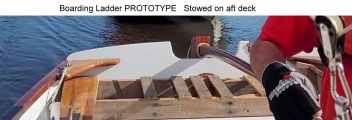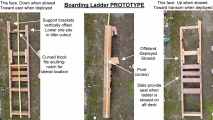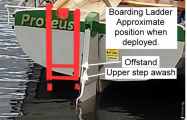Introduction - Why? - We've learned + Methods - The Ladder - Capsize Party 2024 - Capsize Party 2025 - Further info Please ask!..
INTRODUCTION - Capsize prevention is infinitely preferable to having to recover, but to "prepare for the worst while ... " we have experimented..
The 2nd UK Morbic Capsize Party took place at Reading Sailing Club in 2024. (The first was in 2021)
The lake water is normally warmest in late autumn but un-seasonal floods in September obliged postponement.
It was an extremely valuable and potentially life-saving exercise . We all learned important lessons -
Some crews have already stated they need more capsize practice..
[Skip to Capsize Party 2024 report]
WHY? -
THE AIM - To enable sailors to share experience, learning and camaraderie, in controlled conditions.
Experience shows - Righting a Morbic after capsize is relatively easy - RE-BOARDING a Morbic can be CHALLENGING ! !
How do we know? - We've watched crews doing it, done it ourselves, and studied videos.
We've learned -
- Dry capsize Is optimum, if you can do it - or
- Climb up via the C-Plate housing (Horizontal-ish when capsized) to the top gunnel - (Can work OK though there could be some concern that Morbic would "turtle" in certain conditions.
- Then from the top gunnel, simply slide over onto the root of the C-plate, then slide back in as Morbic uprights.
- Alternatives - After righting -
(a) Board over the side, with or without ladder - Is tricky and can re-capsize a Morbic - Not recommended.
(b) A strop or stirrup secured at the transom or rudder - Can work but could be challenging for some folk, and in real capsize conditions.
(c) Our Mk2 ladder is our solution for all conditions and all people. No need to rush or have great agility.
Our Morbic-specific Mk2 wooden boarding ladder -
- Has proved successful - It is our solution for all conditions and all users.
- It stows on the aft bench, loosely tethered at its upper end by a line to the port quarter-knee.
- Is reachable in the swamped Morbic, when “swimming”.
- Is deployed without untying the tether.
- The "off stand" swings out to keep the steps vertically above each other and away from the transom. (Strops and rope ladders swing under the hull)
- The top step is awash. Middle step is submerged 270mm. Bottom step is submerged 540mm.
- Off-the-shelf equipment is unlikely to be the right dimensions, and is just not aesthetically Morbic-worthy!
- Pics below show our prototype
- Our Mk2. version in oak, is slimmer, more comfortable to sit on, and more beautiful. (pics coming soon or available on request)
- CAVEATS - (i)
The depolyed ladder tends to float up till human weight is applied - We will add ballast below the bottom step - (ii) dimensions have been slightly adjusted since the prototype.
. Introduction - Why? - We've learned + Methods - The Ladder - Capsize Party 2024 - Further info Please ask!
The 2nd Uk Morbic CAPSIZE PARTY - 9th November 2024 - Reading Sailing Club
(The first was in 2021)
The lake water is normally warmest in late autumn but un-seasonal floods in September obliged postponement.
THE AIM - To enable sailors to share experience, learning and camaraderie, in controlled conditions.
Would you like to attend the next one? Please say.
ARRIVAL-
Six Morbics were present - The largest number of UK Morbics ever gathered anywhere! - Half the English Fleet.*
 Car park - Six Monbics together |
Click pics to enlarge |
 Six Morbics Afloat, (one in background). |
THE CAPSIZES -
SIx sailors performed capsize / re-boarding.
All capsizes were away from the shore.
Recoveries were unaided (although some of these sailors won’t see 70 again!)
Times & Videos - Capsize to Bailing-Ready:-
> Best = 60 seconds. = "Half Moon" - Video.
>
Next best = 1:45. = "Aura" - Video.
> Poor = 4:36 = "Proteus" - Video.
> Slowest = 8:00 plus. - (Video of 4 minute recovery in 2018)
 Why did Proteus roll so far over? |
Click pics to enlarge |
 Mast horizontal. Ladder visible |
"DISCUSSION"
An extremely valuable and potentially life-saving exercise.
Crews stated they need more capsize practice - All learned important lessons.
Thank you all who participated.
| PARTICIPANTS’ COMMENTS 2024 + Suggestions for consideration . Mainly inspired by the Capsize Party | |||
| Practice |
“I need more capsize practice” | Yes – Who doesn’t? | |
Before Righting should we Release all Sheets? |
|||
| Main sheet? - “ … wondering about releasing the main sheet once I’d capsized - must do this if there is any wind. “ | Keeping it un-cleated when sailing in gusty weather is recommended. | See "talexb" (4th comment down) >here< " the skipper should have had the main sheet in his hand at all times. That way, as soon as a gust hits, they can let the main out and re-balance the boat." | |
| Jib Sheets? | Probably a good idea – Better chance of keeping head to wind. | ||
Main Halyard - "Before righting should we release the main halyard?" |
|||
| . | “ … wonder whether I should actually release the main halyard [before righting] in strong winds - less chance of a second capsize or being blown downwind.” | Maybe having the spar “up” the mast helps stability while the boat is capsized? e.g. limit the risk of turtling? Perhaps one could release the halyard before righting, so the spar would fall as the mast comes up? The rig would lie on the water downwind. | |
| Righting Lines. | |||
| “I think a righting rope is what I need…” | If you capsize in “real conditions”, can you expect to be able, to throw a righting line over the hull, into the wind (as it would be) with any degree of success or accuracy, (e.g. Swefn) – I wouldn’t. Consider securing a line amidships (Morbic frame 3) on each side? Run them over the gunnel, then aft to the transom where they could be Velcro-ed for easy release when swimming around to the C-Plate. It could also prevent you from drifting away from your boat. They will also make a useful breast lines (very handy when arriving alongside a mooring.) (I’ll try to find pics of one seen ont’web where it is hitched at the transom, as above.) |
See instructor "rachelthomas" >here<) "the first step in any capsize ... get to the back of the boat to ensure safety in case of a total inversion." | |
| Centre-Pate Retention | |||
| "I’m going to fit catches to stop the centreboard and rudder from coming out (they didn’t on the day but I can see that they might)" | Viviers' design specifies C-Plate is retained by a shock-cord. See this on Proteus. It works. Includes built-in "cleats".. | ||
| Re-Boarding - Side? / Ladder / Strop? / A built-in step on the rudder or transom? | |||
Boarding over the side - “it is better to be a little further aft (just behind the thwart) to benefit from the extra stability there and reduce the risk of the boat turning back onto you, which could easily happen in a wind.” "Would it work safely in rough conditions? – The risk of re-capsizing seems very real." |
Boarding over the side seems to be quickest and successful IF you are light and agile, but you must be quick. Further aft is clearly more stable than forward – And it is lower! |
||
"Is boarding over the stern preferable?" "...because the stern on the Morbic is so high, rope ladders or stirrups are unlikely to work and a ridged solution (like Proteus') is probably the way to go. |
It is likely boarding over the stern will always be the safest, and possibly the only way in real capsize conditions, especially for less nimble sailors "Proteus" has a taylor-made transom ladder. It stows on the rear deck serving as a bench. |
|
|
| "Can you climb up INSIDE the boat?" | Yes - It has been done - See here. | ||
| Dry capsize is also possible | And preferable! | ||
| Stability while Flooded | |||
"Re-boarding or inboard - Morbic is stable when swamped unless your weight is forward of the main thwart." |
Morbic can be sailed when swamped, but be cautious if going forward. Most of the water lies between the two side buoyancy tanks/lockers, so the free-surface is fairly limited and Morbic is surprisingly stable when she is stern-down. | ||
Bailers - What type - Best stowage? (& see "Stability" above) |
|||
"Swefn’s bailer is stowed under centre thwart with a quick release clip." "A multi-purpose bucket is stowed on a sprung hook. (Quicker to release than knots.)" "A (hand) bilge pump is too slow for so much water." |
Proteus has two. The handles of both are stuffed with polystyrene for buoyancy. They have never floated away during capsize. We know one dinghy sailor who swears by his electric bilge pump |
||
"Swefn carries a throw bag attached to the boat." |
|||
| GENERIC POINTS | |||
Before "Going to Sea" - |
Check drysuit seals and zips, PFD crutch-strap. Check all buoyancy hatches, bungs, etc. Check rudder retention. Secure loose items. Get more capsize practice "It might never happen, but better to prepare for the worst while .... ." |
||
| Why did Proteus uncharacteristically go a long way over? | Any thoughts, folks? | PW aims to research this (in warm water)! | |
| Any more topics to add, folks? | Please contaxt PW | ||
Would you like to attend the next one? Please say.
OTHER CAPSIZE RECOVERIES (YouTube):-
Capsizing Mirror.
Laser Capsize Recovery + analysis .
FJ + interesting "Comments" below the video.
Vivier Ilur .
Another Laser .
Dry Capsize and Recovery .
* The total potential fleet of known UK Morbics is about 15 but some are inactive, "status unknnown", or not actually in England. We believe the current active English Fleet is 12.


